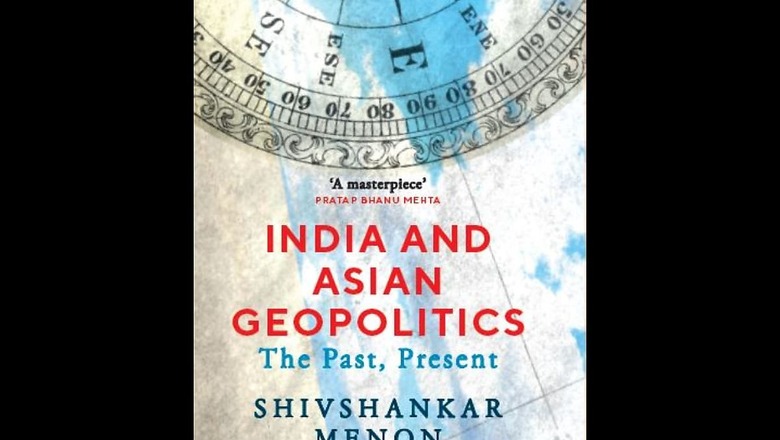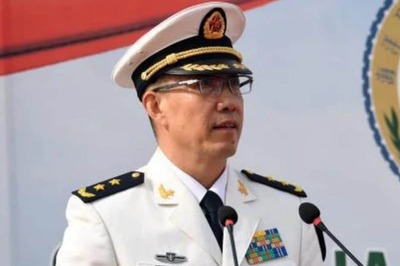
views
India’s interests, like Asia itself, are greatly affected by how a rising China chooses to behave. As China turns to the sea, it is in a more comfortable geopolitical position than at any time since the high Qing conquest of the Dzungars in central Asia at the end of the eighteenth century. Through its long history, its preoccupation was to defend a geographically open inner Asian frontier against the nomads of the northern steppe belt that hatched several dynasties that ruled China—from the Tang to the Manchu or Qing. That is now changed. China’s task of neutralizing and managing the Eurasian heartland has been considerably eased by the division of that steppe belt into smaller and weaker states, and by the retreat and diminution of Russia after the collapse of the Soviet Union. For the most part, Chinese power has been pushing at an open door on land, with the exception of south Asia, where India too is rising and expanding its interests, and in Korea, where partition of the peninsula and a U.S. military presence limit China’s ability to shape outcomes.
China’s turn to the sea is a consequence of the pattern of its recent development. Having relied on export-led growth to build its own manufacturing, China’s future growth now requires continued access by sea to the world’s energy, essential raw materials, food, markets, technology, and capital. Like India, external merchandise trade accounts for a little less than half of China’s GDP. And to defend these interests China seeks to transition into a maritime power. But it faces more difficulty at sea than on land. What is new for China is that it now must think as a maritime power, something it has never done for any extended period of time, if at all. Zheng He (1371–1433) is often cited as the exception for he voyaged in the Indian Ocean during the early Ming with a large “treasure fleet.” But it could equally be argued from his conduct and the Chinese record itself that these voyages were a maritime variant of the overland expeditions to barbarian lands in central Asia that the Ming and other Chinese dynasties undertook to obtain control of trade routes, receive submissions and bring back treasure, and that they do not provide a guide to how China will act as a maritime power at this very different stage of its history.
After 2008 China, apparently acting on the presumption that a West in decline would accommodate its drive for primacy in Asia, attempted a two-track strategy, neither track of which succeeded entirely. The first was to increase its commitment to its two de facto allies, Pakistan and North Korea, while bearing down in its immediate periphery on Japan, Vietnam, those aligned within the Association of Southeast Asian Nations, and others in the South China Sea and the East China Sea. The other was to offer a cooperative understanding based on parity to the United States in the guise of “a new type of major power relationship,” which, in the Chinese understanding, would leave each to pursue its own “core” interests in its own spheres of interest. Though initially tempted, the United States soon realized that accommodating China’s definition of its own core interests in the South China Sea and elsewhere would circumscribe U.S. ability to operate throughout the Asia-Pacific, lose it allies, and offered little in return on core U.S. concerns. Besides, it went against the grain of U.S. grand strategy since World War II to prevent the emergence of a peer competitor in the international system. The balancing responses to these Chinese actions were a U.S. “pivot” to Asia and the formation of informal countervailing coalitions by powers in China’s periphery: India, Japan, Vietnam, and others have increased their defense, security, and intelligence cooperation considerably.
China reacted to the initial pushback by readjusting its strategy in 2012 from a largely political and military strategy, focused on the South China and East China Seas, to a broader geo-economic strategy using its economic strengths, crystallized in Xi Jinping’s One-Belt-One-Road proposal of 2013, subsequently renamed the Belt and Road Initiative (BRI).
A third policy option was logically available, though China has not yet tried it, which was to work with significant local powers in the region and its periphery—consulting with Japan, India, Indonesia, Vietnam, and South Korea, for instance—to evolve a new security order in the Asia-Pacific, based on mutual respect for core concerns and managing differences that exist. This would require an accommodation (and redefinition) of China’s and others’ core interests, but this may be politically difficult for leaderships in the present ultranationalist climate. While awaiting such a process of redefinition and agreement on core interests, confidence building measures, crisis management mechanisms, and communications arrangements between the powers would be required to restore a sense of security in the Asia-Pacific. It would be logical to start such a process with maritime security, where all the major Asian powers, including China and the United States, have a common interest as significant trading nations in maintaining security and freedom of navigation throughout the region. The more difficult issues that any collective security system would have to address would be the effects on the Asia-Pacific of terrorism and non-state actors, of new military doctrines and postures, of nuclear proliferation and deterrence, of cyber security, and of political and state fragility in west and southwest Asia, and its spread to southeast Asia, since states like Pakistan are themselves involved in abetting and creating some of these phenomena.
Instead, China has chosen to go its own way, relying on its own economic, political, and military power to secure its interests in Asia and to remake the Asian order.
For its neighbors, the most evident symbol of China’s new power, and of its intention to project that power, is the People’s Liberation Army (PLA). China’s military is the transformed product of three decades of double-digit budgetary growth and the building of infrastructure to support it. The military reforms of the last few years have transformed the PLA from an instrument of national consolidation into an expeditionary force, an instrument of power projection with joint theater commands based on the U.S. model. For India one direct consequence is that mobilization times in Tibet have shrunk from two seasons to two weeks, as shown by PLA exercises in Tibet in the last decade practicing for contingencies on the border with India and within Tibet, and displaying China’s rapid mobilization capabilities. China has also modernized its nuclear and missile forces into a more capable second-strike force and developed medium- range ballistic missile and cruise missile capabilities and systems that are altering the regional military balance, even with the United States. A repeat of the 1996 Taiwan Strait crisis is no longer possible. China’s merchant marine fleet is built to PLA specifications. A large fleet of Coast Guard vessels and modern diesel submarines can project power and threaten surface vessels in the western Pacific, East China Sea, South China Sea, and, to a lesser extent, into the Indian Ocean. Its fighter aircraft inventory has grown to the point where China felt strong enough to declare an Air Defense Identification Zone in the East China Sea in November 2013, with hints of one to follow in the South China Sea. China has built up significant offensive capabilities in asymmetric warfare, in cyber war, in missile and strategic forces, and in power projection platforms such as submarines and aircraft carriers.
The ports and other infrastructure that it has built or is buying in the Indian Ocean littoral and the Mediterranean are now useful to the PLA Navy. China established its first PLA base at Djibouti, has access to Gwadar and Karachi, and is building or managing ports at Hambantota, Kyaukphyu, and other locations around the Indian Ocean and around the world. At the southern end of Laamu atoll in the Maldives, the island of Gaadhoo guards the one-and-a-half degree channel through which most Indian Ocean shipping passes. Gaadhoo was said to have been secretly promised to China by former Maldives president Abdullah Yameen and was cleared of its inhabitants during his presidency. China’s accumulation of the hardware of power is accompanied by a shift in China’s declared willingness to project and use power, described in the May 2015 White Paper on Military Strategy. The strategy gives military effect to Xi Jinping’s shift away from Deng Xiaoping’s twenty-four-character strategy of “hiding one’s light and not taking a leadership role.” PLA reforms since 2015, not just of the military commands and regions but in the role of the political commissars, and functional and other military changes, show a determination to change the PLA in fundamental ways into an instrument for power projection able to fight short, intense, high-technology wars in “informationalized” conditions outside China’s own territory and immediate periphery. It has therefore further developed maritime and air capabilities. We have seen a regular presence of the PLA Navy in the Indian Ocean since 2008, including nuclear missile submarine patrols after 2014.
These steps provide the military underpinnings for the larger economic and political role that China seeks for itself in its periphery and the Asia-Pacific today and in the world tomorrow. Xi Jinping’s signature connectivity and economic integration of the BRI, binding China and Eurasia overland to Europe and by a maritime route, will soon have Chinese military capacity to back and protect it. If the BRI fails, it will not be for lack of enforcement capability or top-level Chinese leadership commitment.
***
The slow global economy since 2008, further affected by the COVID-19 pandemic, makes China even more important to the world as one of the few sources of global growth. The International Monetary Fund estimates that China accounted for 25 percent of world GDP growth in 2017, and India for 15 percent. But its own economy has been slowing too, and could pose an internal challenge to the legitimacy of the Chinese regime. The legitimacy of single-party rule by the Chinese Communist Party (CCP) was originally based on socialism, nationalism, and communist ideology in the 1950s and 1960s. The Great Proletarian Cultural Revolution gave ideology a bad name, and was a form of political inoculation that gave mass politics a bad reputation in China. After Deng Xiaoping’s reforms began in 1978, the Communist Party’s claim to rule was based primarily on delivering rapid economic growth. This has now slowed to less than 6 percent according to the regime, or 2 to 4 percent, according to some foreign observers. The regime therefore increasingly relies for its legitimacy on nationalism, verging on ultra-nationalism or nativism, and on the leader’s charisma and personality cult.
Internally, the CCP’s ability to control a much more complex society and economy was under threat with the rise of a middle class and incomes outside the state sector. Technology, particularly information and communication technology, compounded this problem. China today spends more on internal security than on national or external defense. Ever since the 1989 Tiananmen Square killings, the Chinese state has explicitly prioritized “stability above all else.” Since 2012 under Xi Jinping, CCP command and control has been tightened with a drastic recentralization. Patronage networks and systemic corruption had weakened the party considerably. The anti-corruption campaign has served as a political tool to eliminate rivals and build a Xi faction in the party. As the legitimacy of party rule weakens, Chinese leaders have also used external threats to justify domestic controls.
We are now dealing not just with a changed China but with changed Chinese statecraft. A reconstructed history and the contemporary environment drive a more assertive Chinese external engagement and complex statecraft. China today fields less-sensitive diplomats, who seem not to count for much at home, and whose recent actions, called “wolf warrior diplomacy” after a popular series of action movies, are calculated more to show loyalty at home than for their effect abroad. As far as we can tell the PLA has considerably increased its role in policy formulation. The security hierarchies—PLA, state security, public security—and the central party departments have much greater policy weight in relation to the economic ones—the State Development Research Council and others—which were supreme in the 1990s and early 2000s under Deng Xiaoping, Jiang Zemin, and Zhu Rongji. And decision-making has been centralized to an unprecedented degree. Regime stability and the maintenance of one-party rule remain the highest priorities of the Chinese regime.
Read all the Latest News, Breaking News and Coronavirus News here. Follow us on Facebook, Twitter and Telegram.




















Comments
0 comment